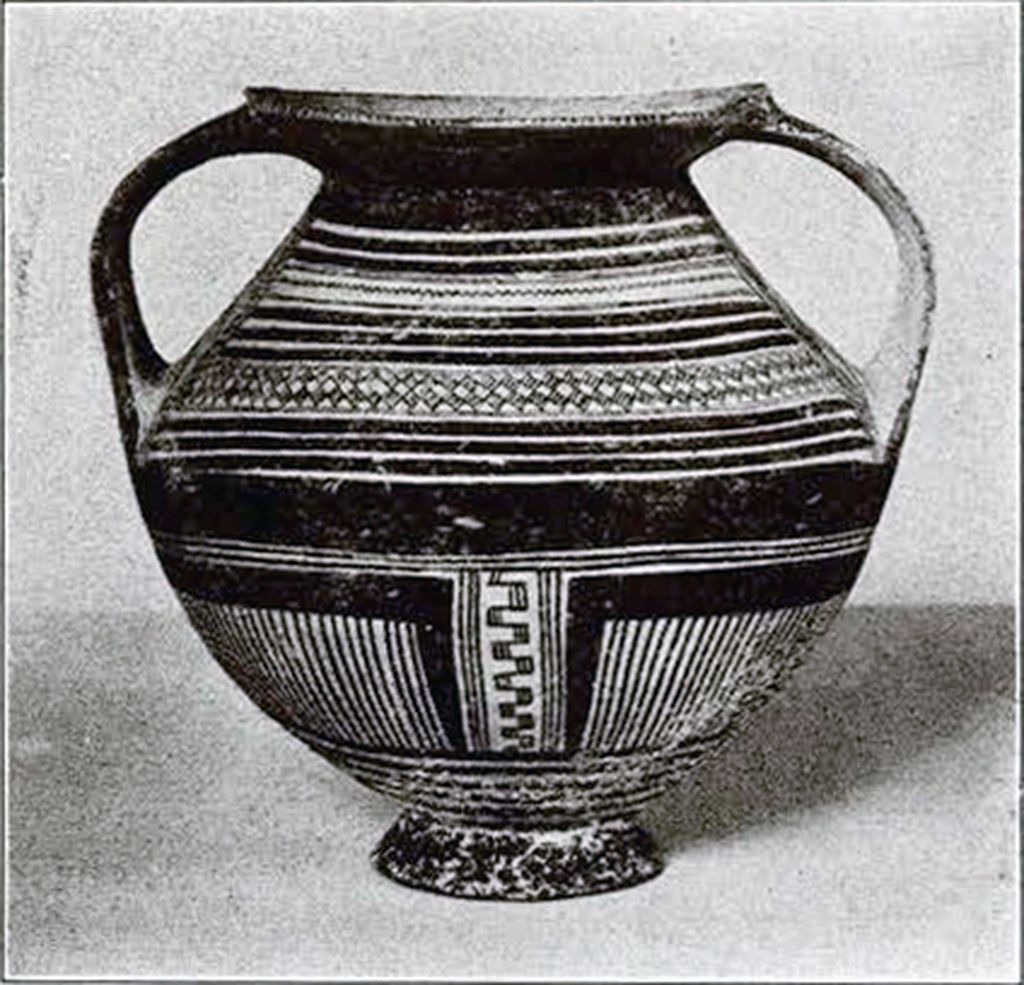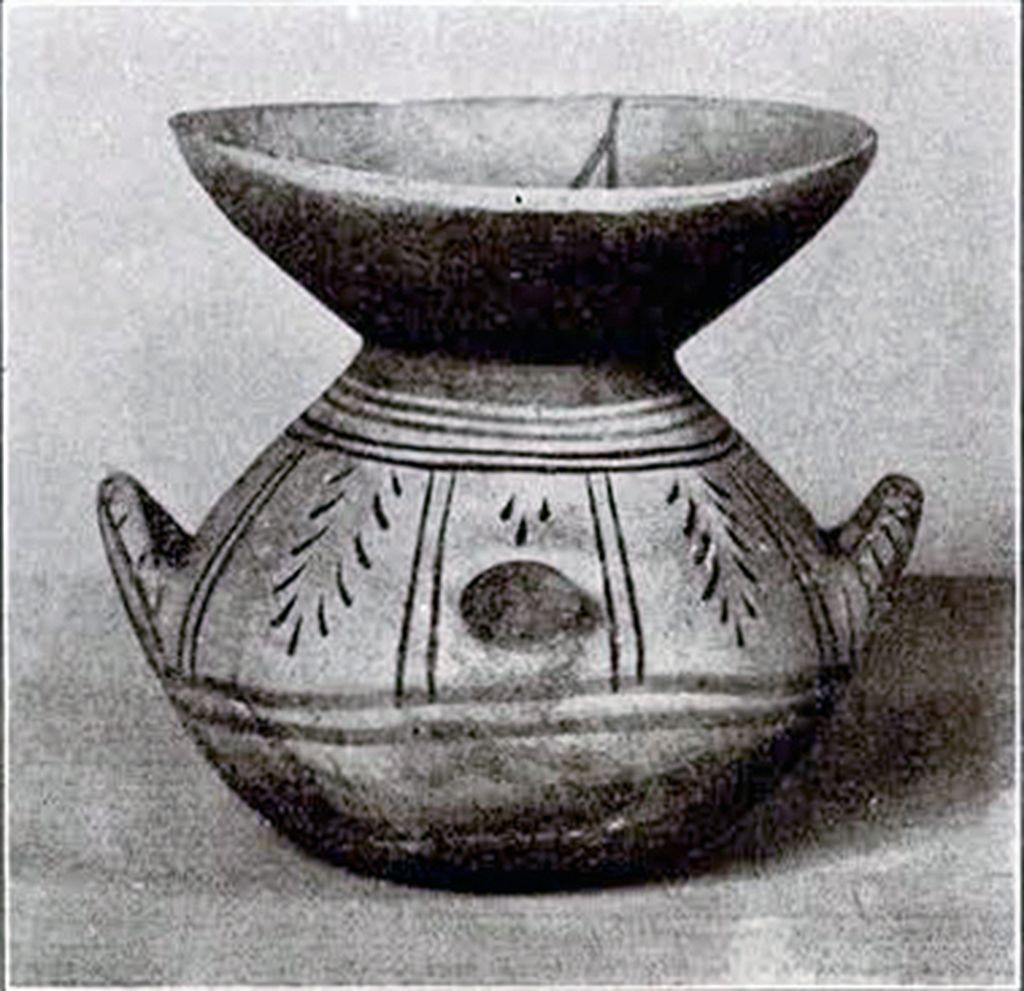I. Pre-Hellenic Pottery
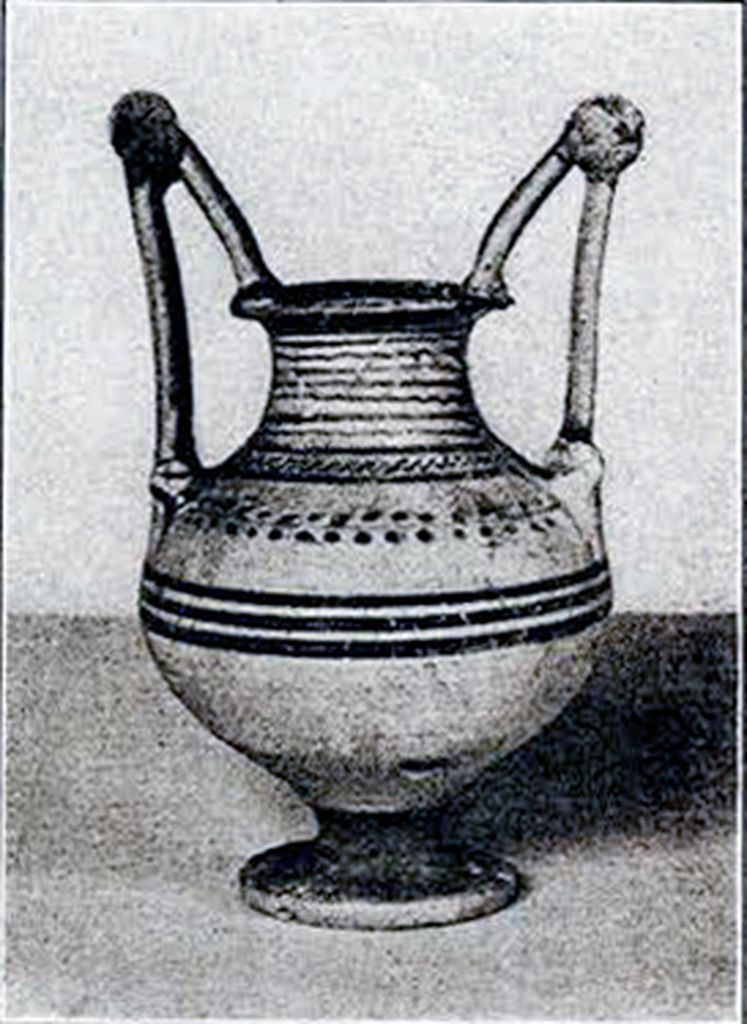
Museum Object Number: MS205
Image Number: 4697
One of the most fascinating problems confronting the classical scholar, be he philologist, historian, or archæologist, is briefly summed up in the following words: “What sort of people did the Greek colonists in Southern Italy find there upon their arrival? What kind of civilization did they have, what language did they speak, what opposition, if any, did they offer to the settlers from the East?”
This question has long remained unanswered, nor can we even now arrive at any very satisfactory conclusions. There is not the same mass of material that exists in the case of the Etruscans. The Greeks have, from earliest times, been able easily to assimilate the peoples with whom they come into contact. Today the Greeks, a race made up of many different elements, and almost as composite as our own, have completely Hellenized the Albanian, Slavic and Vlach groups within their boundaries, who speak the modern Greek language, and are fast forgetting, or rejecting, their original tongues. And in antiquity we find that in the South Italian colonies, the indigenous inhabitants quickly merged with their Greek neighbors, and became Hellenized in every way. To show how thorough such amalgamation may be, and how permanent a mark it can make, it is said that at Taranto (the modern city on the site of the ancient Tarentum, and now one of Italy’s greatest naval bases) there is a quarter where, to this day, a dialect of Greek is spoken, and where the traveler would find modern Greek more useful than Italian. This, of course, does not reflect Hellenic, but rather Byzantine influence; but it is a fact that, although captured by the Romans in the Second Punic War, when it espoused the cause of Hannibal (209 B.C.), Tarentum was, in all respects, a Greek city in the early days of the Empire, two hundred years later.
The ancient authors themselves, to whom one would naturally turn for information, are very vague in their ideas of the original tribes inhabiting Southern Italy. For Apulia, which forms the subject of this paper, the term “Iapygians” is used, sometimes to include the whole population of that district, sometimes merely as the name of a tribe in the heel of Italy. It would seem as though “Iapygia” finally represented a stretch of territory taking in the modern compartment of Apulia from a line drawn between the towns of Canosa di Puglia (the Canusium of Roman times) and Barletta, south to the end of the heel. This includes such cities and towns as Bari (the ancient Barium), Ruvo di Puglia (Rubii), Brindisi (Brundisium), Fasano (near the site of the ancient Gnathia), Lecce (Lupia) and Taranto. This is approximately the territory assigned by Herodotos to Iapygia. This region can be roughly divided into three districts, according to tribes: (1) Messapia, practically the modern Terra d’Otranto, including the cities and museums of Brindisi and Lecce, and especially Taranto; (2) Peucetia, which takes the modern Terra di Bari, as far north as Ruvo di Puglia, and including, besides Ruvo, with its famous private collections of antiquities, the city of Bari, with its museum; and (3) Daunia, extending north from Ruvo to Barletta and Canosa.
As historians have failed us in discussing the characteristics of these races, owing to the fact that, even when Herodotos wrote, the Hellenization of Apulia was practically complete, we must resort to the spade of the archæologist to ascertain the cultural development of these early Italic peoples. And here, until within the last fifteen or twenty years, the results have been meagre. Southern Italy has not been systematically or scientifically excavated until recently, and much remains to be done. Already, however, a large quantity of material has been unearthed and housed for study in the museums of Bari, Taranto, and Lecce, while, previously to that, a considerable number of objects of this kind had found their way into the National Museum at Naples, and the Jatta collection at Ruvo had acquired some interesting specimens.
The “finds” take, for the most part, the form of local pottery, and three distinct fabrics appear, each one centering in one of the districts indicated above, which, indeed, makes it possible for the archaeologist to define these districts. There are, therefore, the so-called wares of Messapia (apparently having Lecce and Taranto as centers of manufacture), Peucetia (with Bari and Ruvo as its centers) and Daunia (with its principal point of manufacture at Canosa). Perhaps the best place to study all these techniques together is the Museum at Bari, which, being in the center of Apulia, the capital of the Terra di Bari, and the principal city of the compartment, has had exceptional opportunities to gather together a large and representative collection of early Apulian pottery. Moreover, Dr. Max Mayer, the former Director of the Museum, was one of the pioneers in this field, and has contributed much to our knowledge of this period. Of late, however, the Museum of Taranto, under the able and energetic direction of Signore Quagliati, has pushed to the fore, and is today nearly, if not quite, as profitable a place for the investigator to study.
The Museum acquired, some twenty years ago, a small, but representative collection of local Apulian vases, which, added to some others received from other sources, gives us at least one (and in one case two) of each of the three techniques.
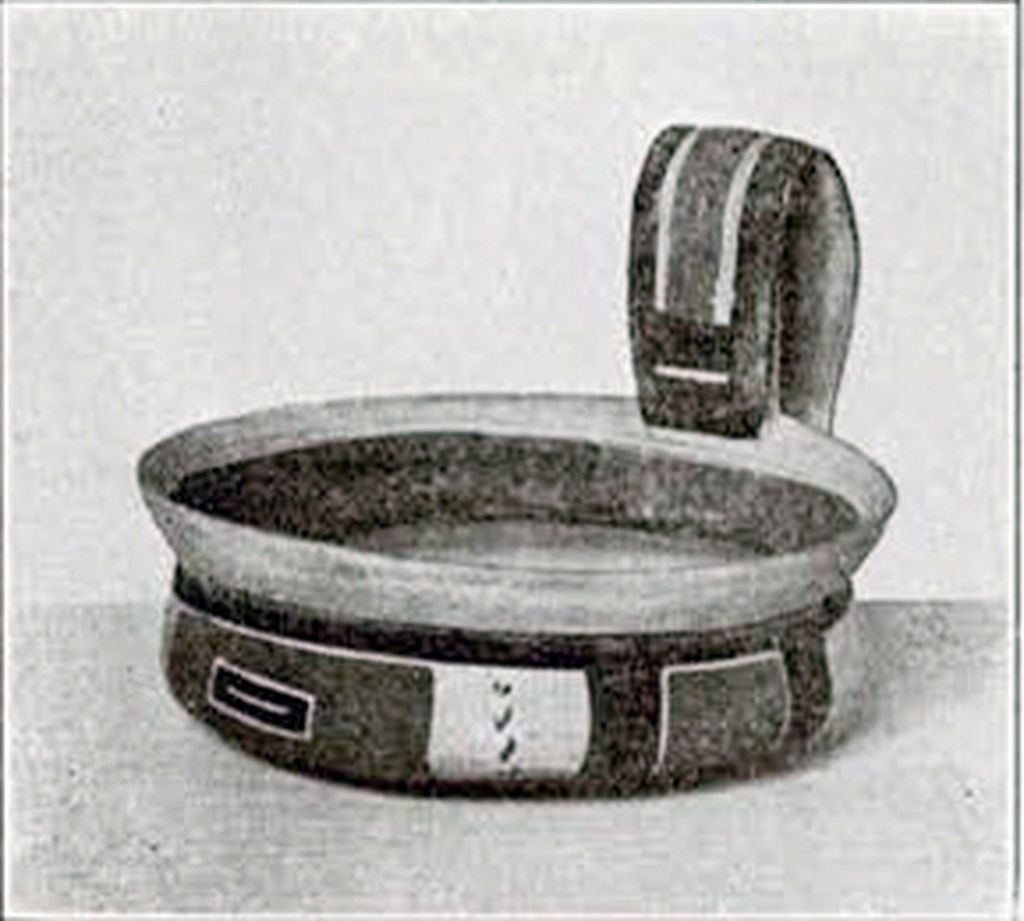
Museum Object Number: MS301
Image Number: 4696
Messapian ware is represented by a small amphora, or perhaps more correctly called a krater (Fig. 74). These vases are called by the Italians “vasi con maniche a rotelle,” from the discs on the handles. This vase was found at Rugge, a modern town of no particular importance in the Terra d’Otranto, not far from Lecce. In ancient times it was called Rudiae, and was the birthplace of Ennius, the father of Roman literature. This type of vase is characteristic of the Messapian ware, as the great majority of vases found in this district are of this shape. One of the handles has been broken and mended, but the vase is otherwise intact. It is decorated with leaf patterns and linear decorations on a cream-colored slip, and betokens a relatively high state of culture. It was presented to the Museum in 1894 by Dr. C.C. Harrison, the present President.
This vase bears out the theory that the pre-Hellenic culture in the heel of Italy had reached a more advanced stage than in the more northern districts of Apulia. The fact that the Messapians were able to inflict a severe defeat upon their Greek neighbors of Tarentum in 470 B.C. bears witness to their virility and strength. Furthermore, their intellectual development is proved by a series of inscriptions found in the region, a few of which have found their way into the Museum of Taranto. It is significant that no pre-Hellenic inscriptions appear to have been found in the Peucetian or Daunian districts.
Coming now to the Peucetian ware, we find it represented by a large krater (Fig. 75) the provenance of which is unknown. This vase is intact, and is an excellent specimen of this fabric. It is covered with decorations of a geometric nature in black on a cream-colored slip, laid over the buff clay. These decorations are in bands on neck and shoulder, while below the black is applied very heavily, leaving panels of white in which linear decorations are painted. Even the bottom of the foot is decorated. This is an excellent example of Peucetian ware.
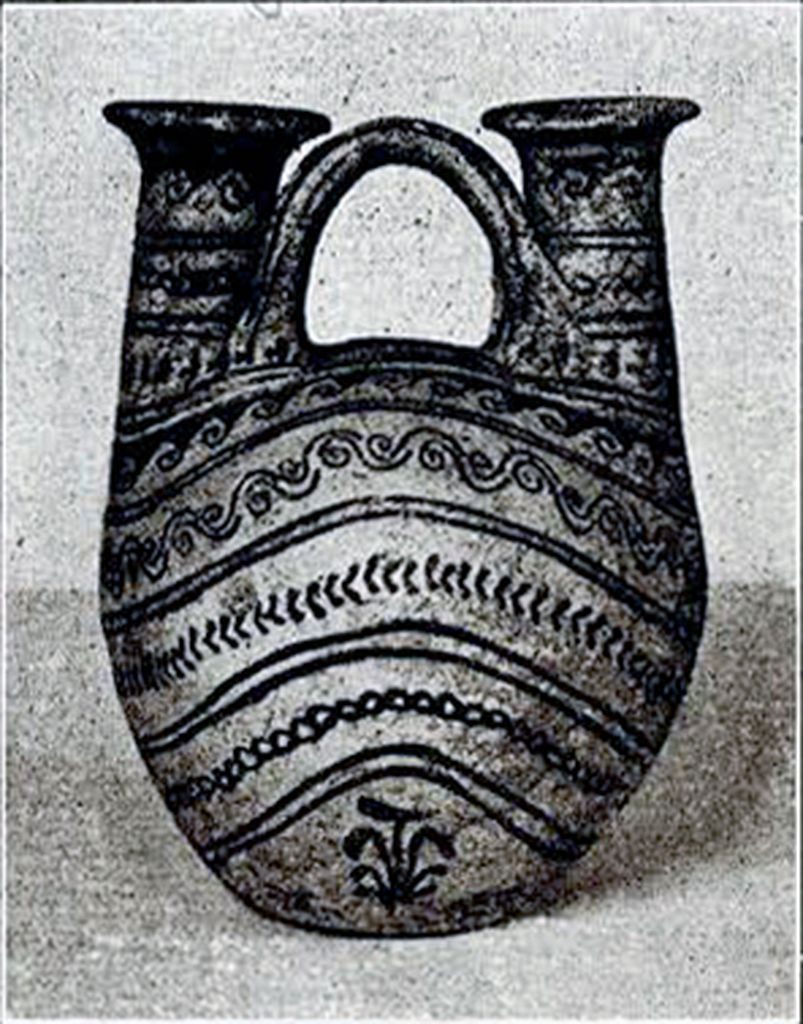
Museum Object Number: MS1591
Image Number: 4693
Two specimens in the Museum’s collection seem to represent the Daunian ware. First of these is a large krater, or bowl, of a form resembling the much despised cuspidore of today (Fig. 76). This vase has Messapian characteristics in technique, but the shape appears to be of Daunian type. Vases of this form are frequently found in pre-Hellenic excavations, and the writer has seen them in great abundance in the museums of Bari and Taranto.
There are two side handles, and, on the opposite sides, two little lugs or knobs. The decoration is in red and black, laid directly on the light clay, which has turned red at the bottom from over-firing. It takes the form of horizontal rings around the body of the vase in red, and very rough palmette-like ornamentations pointing downward, and a series of vertical lines in black. The inside of the flaring mouth is decorated with a circle and tangents to it in red. The provenance of this vase is unknown.
The student who receives, as the writer did, his first introduction to the pre-Hellenic pottery of Apulia in the museums of Taranto and Bari, will remember this shape above all others that he sees. More of them have been found than any other type, and the extraordinary and unclassical form will impress itself far more readily than any other shape. But although they are found, apparently, all over Apulia, they seem to be of Daunian technique, and were probably manufactured in the neighborhood of the modern Canosa.
Emphatically, Daunian is the litttle cup which concludes the series (Fig. 77). This vase of buff clay is covered all over with a cream-colored slip, on which dark red and black decorations are freely applied. It is of unknown provenance, as it came to the Museum with a collection of antiquities from Cyprus. It is, however. unquestionably an example of South Indian indigenous ware, the resemblance of some of which to the pottery of Cyprus is quite pronounced. The resemblance is in all probability entirely accidental.
The designs on the vase are geometric and curvilinear, and are laid on boldly and heavily. An attempt at a leaf decoration seems to have been made in the light panels on the body. In this case, as in the case of the Peucetian krater, every available space is decorated,
including the inside and bottom.
With regard to the chronology of the vases described above, it is more than probable that they were made in the period between 700 and 450 B.C., the Messapian vase being undoubtedly the latest, while the Daunian vases seem to be the earliest.
Vases of this class are not common in museums outside of Italy, and even there do not as a rule appear in any large quantities north of Naples. It is, therefore, a matter of pride that the Museum has, in this small group, representatives of all three of the Apulian indigenous wares.
II. “Local Apulian” Vases Of The Hellenic Period
The question now arises as to what influence the early wares described above had on the Greek ceramic artists of Southern Italy. Did they entirely disappear and leave a clear field for the Hellenic vase painters, or did a “local Apulian” ware continue side by side with the “Greek Apulian” pottery?
In a previous number of this JOURNAL the writer has attempted to describe very briefly the Greek Apulian vases, and on view in the Museum are a number of specimens of this class. It is the commonest of all the South Italian Hellenic types. If any influence were derived from the local fabrics, it should be found here. And, indeed, we find that the Greek manufacturers have taken over at least one of the indigenous shapes: that of an “askos,” or bottle, so named by archeologists on account of its resemblance to a wine-skin, which they frequently made and decorated with designs in the new technique.
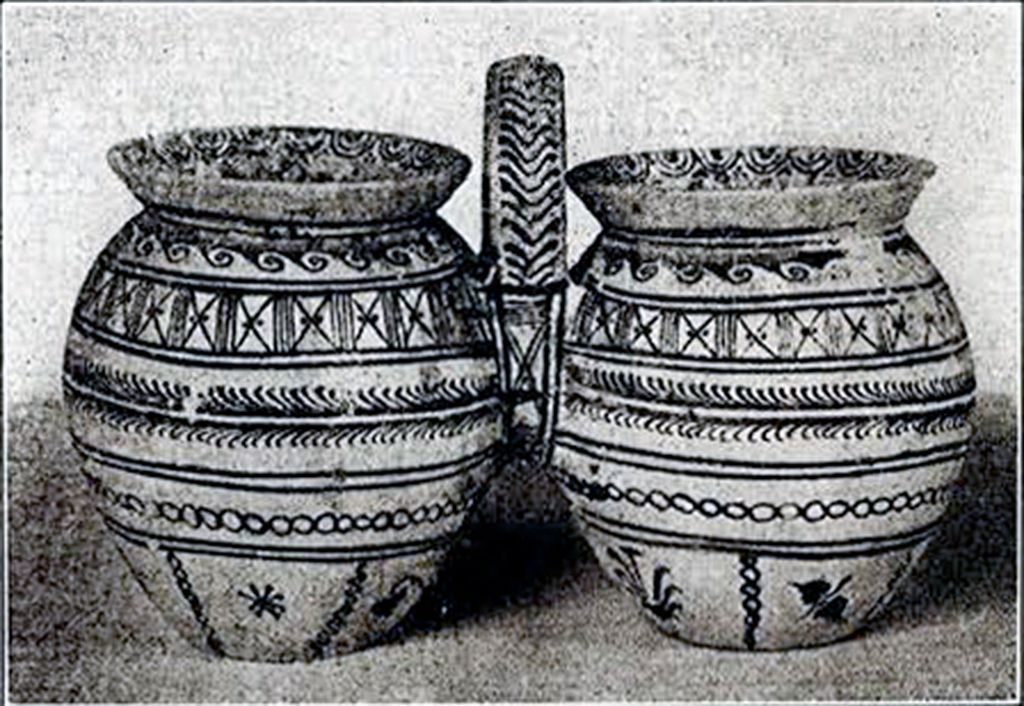
Museum Object Number: MS1590
Image Number: 4692
Strangely enough, however, it is not in Apulia that the principal influence of the pre-Hellenic ware as regards shapes occurs, but in Lucania. This region, which included several of the most famous of the Greek colonies of Southern Italy, such as Sybaris and Metapontum, covers about the same area as the modern compartment of Basilicata, on the other side of the Gulf of Tarentum from Messapia; but the Lucanian potters adopted the characteristic Messapian shape (Fig. 74), and, with certain modifications and adaptations, evolved from it the type known to students of Greek ceramics as the “Lucanian Krater” sometimes erroneously called “Nestoris.”
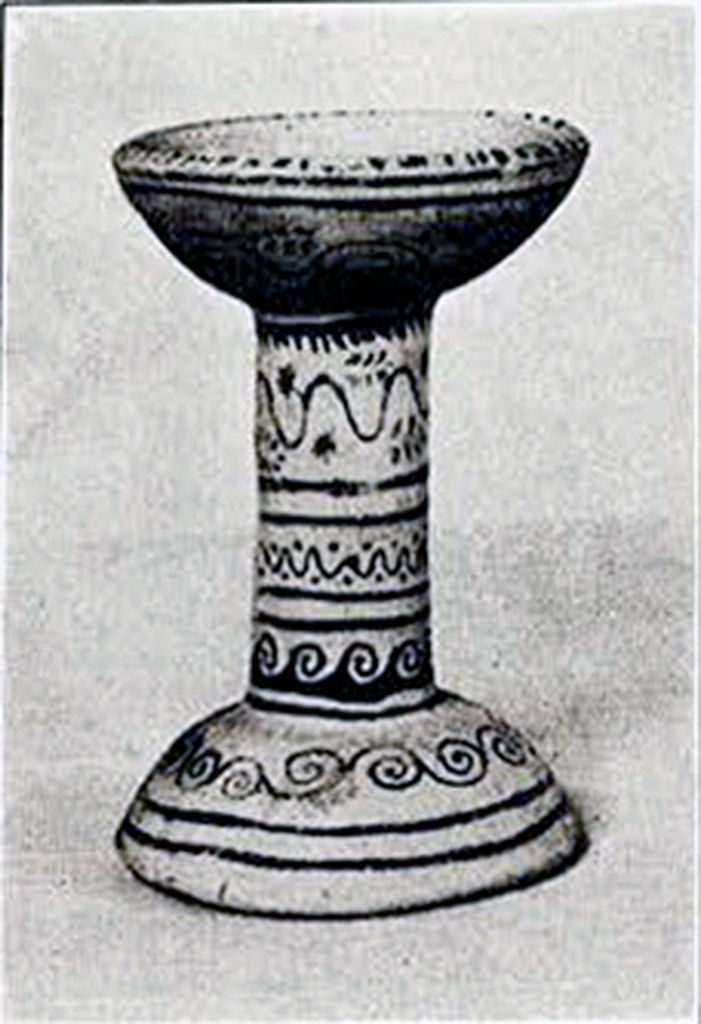
Museum Object Number: MS1595
Image Number: 4694
It is doubtful still whether a “local Apulian” ware existed side by side with the Hellenic technique, or whether the only influence lay in the adoption of native shapes by Greek potters. The more modern opinion seems to be that the so-called “local Apulian” vases that have occasionally been found are much later, and succeed the Hellenic style. This contention has been ably upheld by an Italian archaeologist named Vittorio Macchioro, whose paper, published fished in 1910, remains the standard article on the subject. Previously the general opinion of such scholars as Walters and Patroni had been that the “local Apulian” ware persisted side by side with the “Greek Apulian” pottery, and was probably of Messapian origin. Macchioro proves, however, that so far from being Messapian, the center of manufacture was in the area that had in pre-Hellenic times been known as Daunia, as these vases seem to have been made at Canosa. He also proves, from a careful study of kindred finds, wherever possible, and of the archives of the National Museum at Naples, that the “local Apulian” ware was found in late tombs, and finally arrives at the conclusion that it belongs in the third century B.C.
If this is the case, as the writer believes, so great is this resemblance in many respects to the pre-Hellenic vases of Apulia, to the superficial observer, that they constitute a veritable reversion to type, and on that account it is deemed of sufficient interest to add a group of these vases to show how similar they are to, and yet how different from, the earlier specimens.
The technique of these later vases is the same in every case, and the same nature of design is employed. The clay is buff, and the decoration is applied directly to it without the use of a slip, and usually in black, though polychromy is also employed, such colors as brick red, pink, and orange being found on different specimens. To the expert this use of gay colors at once suggests Canosa, as the late class of vases to which this place has given its name, and which are probably a little later than the ones under discussion, are liberally decorated with all kinds of colors. These “Canosa vases” are large polychrome vessels for funeral use.
First in our list comes a group of two vases of the shape known as “askos” from their resemblance to wine skins. As has been stated above, this is an indigenous form of vase, and was copied by the Greek vase painters of Apulia. It was especially common in the wares of Peucetia and Daunia. Walters, indeed, believes that this shape is derived from Ægean sources, but this view is erroneous.
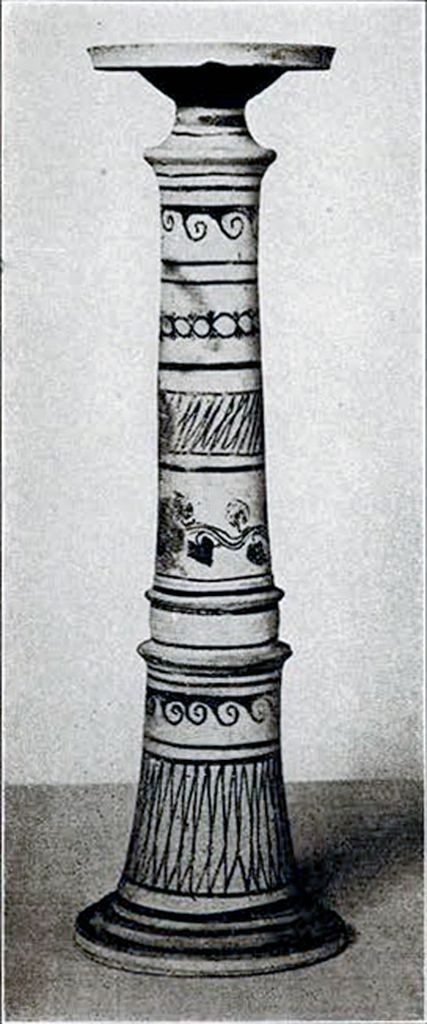
Museum Object Number: MS1597
Image Number: 3100
The decoration on these vases, one of which is here illustrated (Fig. 78) consists in each case in bands of conventional ornament. Two patterns are especially common: the so-called “wave-maeander,” or in Italian, “meandro a onda,” which occurs on both necks and on the shoulder of the vase illustrated, and the “chain” or, in Italian, “treccia” (tress) pattern which also occurs twice on the specimen illustrated, on the necks below the wave maeander and near the foot. Of these two patterns the wave maeander occurs on every vase in the group, the chain on all but one. One of the mouths is closed and perforated, the other open. Polychromy is employed; the inside of the mouth being brick red, and one stripe each of red and pink running round the vase. The askos not illustrated is in poor condition, the designs having nearly all rubbed off; but wave maeander and chain patterns can be recognized.
Next comes a double vase (Fig. 79), consisting of two pots, held together by a loop that has been formed between them. Polychromy is used freely, the colors, beside black, being red, orange and pink. The decoration takes the form of bands, of the same general nature as in the preceding specimens.
The last two vases of the series (Figs. 80 and 81) are usually called “incense burners” (Italian, incensieri). The taller one is said to have been found in Campania, but is unquestionably of Apulian manufacture, and probably was made at Canosa. The bands of decoration are bolder than in the other specimens, and a very naturalistic ivy leaf pattern runs around the center of the vase.
This late pottery of Apulia seems to present a real reversion to type after a lapse of a hundred and fifty or two hundred years. Although the patterns used for decoration are classical, yet the general appearance of these specimens reminds the student of the pre-Hellenic wares. There is, however, a possibility that the writer has not seen suggested elsewhere. It has been observed that the Italian scholar who has fixed the chronology of these vases has shown them to be almost certainly a product of Canosa. It is also apparent that in all the vases of this class in the Museum, the technique is the same. No difference of any importance will be found between these and any in other museums. It is, therefore, the writer’s opinion that a very good case could be made in favor of the contention that not only did they all come from the same place but even from the same workshop, and were the work of the same maker. If this were so, the problem would be intensely simplified, as they would then represent, not a distinct class or period, but merely the product of one atelier, running, perhaps, through one generation ; in other words, not so much a reversion to type as a personal eccentricity or peculiarity on the part of one particular manufacturer. This suggestion is therefore offered to settle the much discussed problem of these “local Apulian” vases.
S.B.I.


